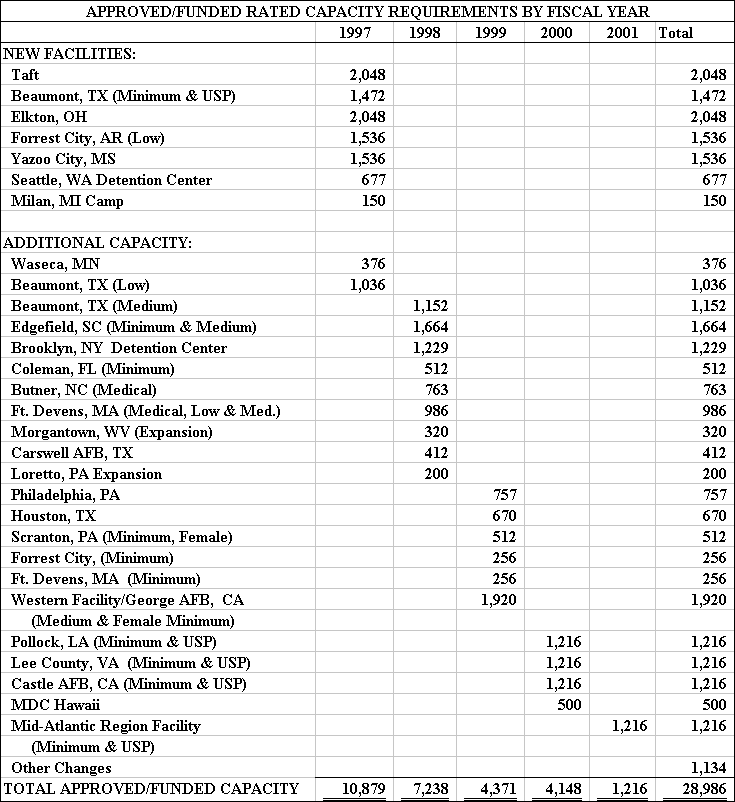
Notes to the Principal Financial Statement
Note 1. Summary of Significant Accounting Policies
A. Basis of Presentation
These financial statements have been prepared to report the financial position and results
of operations of the Federal Prison System (FPS) as required by The Government Management
Reform Act of 1994, Public Law 103-356, 108, Stat. 3515. These statements have been
prepared from the books and records of the FPS in accordance with the form and content for
entity financial statements specified by the Office of Management and Budget (OMB)
Bulletin 94-01, Form and Content of Agency Financial Statements, dated November 16, 1993,
and FPS accounting policies which are summarized in this note. However, please note that
the Department received a waiver with respect to certain provisions of Bulletin 94-01 and
accordingly did not prepare the Statement of Cash Flows and the Statement of Budgetary
Resources and Actual Expenses.
The reported financial statements are different from the financial reports, also prepared for the FPS pursuant to OMB directives, that are used to monitor and control the use of FPS budgetary resources.
The footnotes and related financial information have been presented to reflect combined FPS operations for fiscal year 1996. Where applicable, information is stated by each FPS operating entity. When information is not presented by FPS operating entity, then the information applies to the agency as a whole. The three FPS operating entities are as follows:
B. Reporting Entity
BOP
The mission of the BOP is to protect society by confining convicted and sentenced
offenders in the controlled environments of prison and community-based facilities that are
safe, humane, and appropriately secure, and provide work and other self-improvement
opportunities to assist offenders in becoming law-abiding citizens. The accompanying BOP
financial statement information includes the accounts of all funds under BOP control. At
September 30, 1996, the BOP consisted of 86 institutions divided into six geographic
regions. There were 94,695 inmates confined in the BOP facilities.
Commissary
The Commissary is a reporting entity within the U.S. Department of Justice. The Trust Fund was created by two Department of Justice Orders, No. 2126 on April 1, 1930 and No. 2244 on January 1, 1932. The purpose of the Trust Fund is to provide inmates the opportunity to procure merchandise and services not ordinarily provided by the BOP. In 1932, Congress recognized and approved the existence of the Commissary.
FPI
FPI was established in 1934 by an act of Congress. FPI operates under the trade name UNICOR, as a wholly-owned federal government corporation within the United States Department of Justice, and functions under the direction and control of a six member Board of Directors. The members, appointed by the President, represent retailers and consumers, agriculture, industry, labor, the Attorney General, and the Secretary of Defense. FPI's statutory mandate is to provide employment and training for inmates in the Federal Prison System while remaining self-sufficient through the sale of its products and services.
FPI's customers consist exclusively of federal government departments and agencies, such as the Department of Defense, General Services Administration, and the Department of Veterans Affairs. These and other federal organizations are required to purchase products from FPI, if its products meet the customers' price, quality, and delivery standards, under a mandatory source preference specified in FPI's enabling statute and the Federal Acquisition Regulation.
As of September 30, 1996, FPI had industrial operations at 95 factories located at 58 facilities within the Federal Prison System. FPI's factories employed approximately 17,000 inmates at September 30, 1996, representing approximately 18% of the total federal inmate population. The accompanying FPI financial statement information represents everything under FPI fund control.
C. Basis of Accounting
BOP's, Commissary's, and FPI's transactions are recorded on an accrual and a budgetary accounting basis. Under the accrual method, revenues are recognized when earned and expenses are recognized when a liability is incurred, without regard to receipt or payment of cash. Budgetary accounting facilitates compliance with legal constraints and controls over the use of Federal funds.
FPI however, has a portion of its sales made under contracts using a percentage of
completion method of accounting. FPI determines sales and gross profits utilizing a unit
of shipment basis. General and administrative costs are expensed as incurred. Revisions in
estimated profits are made in the period in which the circumstances requiring the revision
become known. Provisions are made currently for anticipated losses on uncompleted
contracts.
D. Accounting Principles and Standards
Until all Statements of Federal Financial Accounting Standards, which will constitute generally accepted accounting principles for the Federal Government, become effective the following hierarchy shall constitute another comprehensive basis of accounting and was used to prepare these financial statements:
E. Revenues and Other Financing Sources
The FPS receives both annual and multi-year appropriations that may be used, within statutory limits, for operating and capital expenditures to support its programs. Additional amounts are obtained through reimbursements for services. Appropriations are recognized as revenues at the time the related program or administrative expenses are accrued. Appropriations accrued for property and equipment are recognized as revenue and as depreciation expense over the estimated useful life of the asset.
The Commissary operation receives the majority of the funding through revenues generated by the sale of merchandise and telephone services to inmates. Also, the collections of commissions received from products sold through vending machines contributes substantially to net profit. Normally, the Commissary receives no appropriated funds; however, due to a Preliminary Injunction, appropriated funds were used in Fiscal Years 1993 - 1996 to comply with the orders of the Injunction. During Fiscal Year 1996, the Commissary reimbursed to the S&E Appropriation all expenses paid by S&E that would have occurred as a result of normal Commissary operations. Revenues generated from Commissary operations are not restricted to any specific year. The Commissary is the principal operation of the Program. As one of its goals, the Commissary maintains a gross profit percentage of 20% of sales. Each institution is monitored quarterly to assure the gross profit expectations are being achieved.
At the present, coin operated vending machines are in service at the majority of institutions. Vending machines and products sold are provided by independent contractors. The Commissary receives commissions from the contractors based on the volume of products sold through the machines.
The Commissary also earned other revenue from recycling income and employees' club
commissions. The majority of these transactions were done through the use of the debit
card program. The debit card program was approved for Bureau-wide implementation in fiscal
year 1991 by the BOP Executive Staff and is a coinless means of using vending machines. At
present, 47 of 86 institutions are utilizing debit card vending. Inmates purchase
"debits" from the Commissary and these debits are then recorded on a card with
an electronic magnetic strip. The number of debits is automatically reduced with each
purchase. When fully implemented, this program will virtually eliminate the need for cash
(coins) for vending machine sales, laundry, and photocopying services. Also included in
Commissary revenue is investment income.
FPI's revenues from sales of products for fiscal year 1996 were mostly earned from
intergovernmental activities (e.g., sale of manufactured goods and services to other
federal agencies). FPI's revenue was generated from product sales of the following
categories: metals, furniture, electronics and plastics, graphics, services, optics, and
clothing and textile. Interest income (i.e., other income) during the current
fiscal year was earned on FPI's short term repurchase agreements. There were also profits
from disposal and sale of FPI's assets (e.g., sales price was greater than FPI's book
value), scrap sales, and recycling income. Furthermore, there was a recapture of donated
property of which was added back to revenue after having been previously captured within
FPI's Cost of Goods Sold. (This latter transaction had a net effect of zero on the
financial statement as a whole.)
A breakdown of Revenues and Other Financing Sources is provided in the supplemental section of this financial statement.
F. Funds with the U.S. Department of the Treasury and Cash
BOP's Fund Balance with the U.S. Treasury was $1,679,531 thousand as of
September 30, 1996. (This is discussed in detail in Note 2.) On the financial statements,
BOP's Fund Balance is broken down between Entity and Non-Entity Assets. Certain receipts
that are processed by commercial banks for deposit to individual accounts maintained at
the U.S. Treasury are accounted for as Non-Entity Assets. These are cash amounts which
have cleared suspense, clearing, or deposit fund accounts (e.g., Prisoner Deposit Fund
15X6085; Deposit Budget Clearing Account 15F3878). BOP's cash account, which includes
undeposited collections, is minimal given that BOP does not, for the most part, maintain
cash in commercial bank accounts. In addition, BOP has been granted and maintains an
imprest fund which is also included within BOP's cash balance. All of the listed amounts
are available to pay current liabilities and finance future authorized purchases.
Commissary's Fund Balance with the U.S. Treasury was $ 55,937 thousand as of
September 30, 1996. (This is discussed in detail in Note 2.) The Commissary held cash
equivalents outside the U.S. Treasury which represents stamp and coin checks in transit
and drafts in transit. Beginning in October 1, 1992, checks for coins and stamps on hand
or scheduled from Treasury were assigned general ledger account numbers to record the
value of unconverted "in transit" checks. This accounting system change was made
to separate the checks and stamps on hand from the checks and stamps in physical
inventory. Coins and U.S. postage stamps in transit will eventually be sold to the inmates
to provide them access to vending machines and mail service. Actual coins and postage
stamps on hand are included in Inventory (refer to Note 1G). There are no cash balances
held outside the U.S. Treasury except for the coins noted above.
FPI's Fund Balance with U.S. Treasury was $ 92,599 thousand as of September 30, 1996. (This is discussed in detail in Note 2.) FPI's fund balance is comprised of cash and short-term repurchase agreements with the U.S. Department of Treasury. Certain portions of the cash and cash equivalent balances have been internally restricted to provide a sinking fund for future loan repayments and to fund future purchases of inventory related to customer advances. The market value of the repurchase agreement is equivalent to cost. The short-term U.S. Government Securities are categorized as fund balance and not investments since they are short-term, highly liquid, 24 hour investments. These securities are reported at cost, or amortized cost net of amortized premiums or discounts. Premiums or discounts are amortized into interest income over the short term of the investment. No provision is made for unrealized gains or losses on these securities because they are held to maturity.
A complete list of FPS Treasury Symbols is provided in the supplemental section of this financial statement.
G. Inventories
FPI's inventory is categorized into five product categories: metals, plastics and electronics, graphics, services, and optics. Given that the stage of production determines the stage of development, the inventory can be classified into one of the following three phases: raw materials, work-in-process, or finished goods. Work-in-process and finished goods inventories include the costs of raw materials, direct labor, and production overhead. These inventories are stated at the lower of cost or market value using the weighted average method. The recorded values are adjusted for the results of physical inventories taken periodically. Expenditures or expenses are recorded when the inventories are sold.
FPI records, as an inventory allowance (contra-asset) account, anticipated inventory losses for contracts where the current estimated cost to manufacture the item exceeds the total sales price, as well as estimated losses for the inventories which may not be utilized in the future.
Commissary inventories are stated at latest acquisition cost. As of September 30, 1996, the latest acquisition cost valuation did not materially differ from a lower of cost or market valuation based on the first-in-first-out method of accounting.
H. Investments in U.S. Government Securities
This is not applicable for BOP and FPI.
Beginning in fiscal year 1995, the Commissary was granted authority (Public Law 103-317, Section 107) to invest funds in excess of operating needs in securities guaranteed by the United States Treasury. In November 1994, the Trust Fund Program began participating in the Federal Investment Counseling Program through the Department of the Treasury. No commissions or transaction fees are charged by Treasury for participating in the program. Investments are made in any Federal Treasury security available to the public. The amount and length of investments are determined after careful review of cash balances available to defray outstanding payables and other liabilities. Due to the risk of loss, the Trust Fund does not purchase premium securities.
Investments in U.S. Government securities are reported at cost, or amortized cost net of amortized premiums or discounts. Premiums or discounts are amortized into interest income over the term of the investment. The Trust Fund's intent is to hold investments to maturity, unless they are needed to sustain the operations of the Trust Fund. No provision is made for unrealized gains or losses on these securities because, in the majority of cases, they are held to maturity. Throughout fiscal year 1996, an amount was invested in securities which earned interest. The interest received is captured in the Trust Fund appropriation and is used to defray general operating expenses. As of September 30, 1996, the Trust Fund held no investments in Treasury securities.
I. Property, Plant and Equipment
BOP and Commissary own the majority of land and buildings in which they operate and capitalize them on their records. Building space is capitalized based upon the percentage of space occupied by BOP operations which is then applied to the total acquisition cost of the building occupied. The same method is used for Commissary, except the amount capitalized is based upon the percentage of space occupied by Trust Fund Operations. Personal property acquisitions of $5,000 and over are capitalized and depreciated by the Sentry Property Management System (SPMS). SPMS is an automated system used specifically by BOP and Commissary to manage and track personal property. Any equipment with an acquisition cost of less than $5,000 is expensed when purchased. Real property is tracked and maintained on hard copy property records which are held at each of the institutions.
All assets capitalized are depreciated using the straight-line method over the estimated useful lives of the assets which range from 3 to 50 years. Due to the unique circumstances surrounding the purchase of additional Inmate Telephone System (ITS) equipment for the Commissary, full depreciation of this equipment will be realized prior to October 1998. The estimated life of ITS was based on the known usable life of the phone equipment before it will be replaced. Amounts are periodically adjusted based upon physical inventories.
FPI has a very advanced, integrated system, SYMIX, that calculates the depreciation for each property item entered. The system accounts for both real and personal property. The system also accounts for and tracks donated property and equipment, which is recorded at appraisal value at the date of donation. Donated property principally relates to property and equipment transferred from the BOP and other government sources (e.g., ex-military sites). Also reflected in the property and equipment balance are non-operating facilities and equipment.
FPI reports property and equipment at cost, net of an allowance for accumulated depreciation. This balance also includes significant improvements to existing facilities. Repairs and maintenance costs are expensed as incurred. The straight-line method of depreciation is utilized to allocate the cost of the assets over their estimated useful lives, which range between 5 and 40 years.
J. Advances and Prepayments
This is not applicable for FPI.
Advances and prepayments classified as assets for BOP and Commissary on the Statement of Financial Position include the excess amount of funds disbursed to grantees over the total of expenditures made by those grantees to third parties based upon year end data. This amount includes the current balance of travel advances, issued to Federal employees in advance of official travel. Amounts issued are limited to meals and incidental expenses (MIE) expected to be incurred by the employees during official travel. For Federal employees who anticipate and plan for travel, advances are permitted up to 80% of MIE. Actual reimbursements are made at 100% of MIE.
BOP's amount also includes advances (e.g., grant money) which arise whenever BOP provides money to state and local agencies to fund correctional study programs. Another source for advances relates to the Public Health Service (PHS) program. The sole mission of PHS is to provide medical treatment to federal inmates. Money is provided in advance from BOP to PHS, and is designated and expended over time for PHS doctor's salaries, benefits, and applicable re-location expenses. The advances are expended on re-location expenses in the event a doctor(s) has been detailed or assigned temporary duty. PHS receives the majority of the advances.
K. Liabilities
Liabilities represent the amount of monies or other resources that are likely to be paid by the FPS, or a related component, as the result of a transaction or event that has already occurred. However, no liability can be paid by FPS, or a related component, absent proper budget authority. Liabilities for which an appropriation has not been enacted are classified as unfunded liabilities and there is no certainty that corresponding future appropriations will be enacted. Liabilities arising from other than contracts can be abrogated by the Government, acting in its sovereign capacity.
FPI receives customer cash advances on certain contracts to fund significant raw material purchases. This represents Other Intragovernmental Liabilities on the financial statement which is a summary account that includes progress accounts payable to customers.
L. Borrowings and Interest Payable to the Treasury
This is not applicable for BOP and Commissary.
For FPI, there were borrowings payable to the Treasury which resulted from a loan it received from the U.S. Treasury. During 1988, Congress granted FPI borrowing authority pursuant to Public Law 100-690. Under this authority, during fiscal year 1989, FPI borrowed $ 20,000,000 from the U.S. Department of Treasury with a lump-sum maturity or optional date for re-negotiation of September 30, 1998. The funds received under this loan were restricted, by FPI's Board of Directors, for use in the construction of factories and the purchase of equipment. The loan accrues interest, payable March 31 and September 30 of each year, at 9.125% (the rate equivalent to the yield of U.S. Treasury obligations of comparable maturities which existed on the date of the loan). Accrued interest payable under the loan is either fully or partially offset to the extent FPI maintains non-interest bearing cash deposits with the U.S. Treasury. In this regard, there is no accrual of interest unless FPI's cash balance on deposit with Treasury falls below $20,000,000. When this occurs, interest is calculated on the difference between the loan amount and FPI's cash balance. The cash balance on hand at Treasury may differ from the cash balance in the statement of financial position due primarily to vouchers in transit.
The loan agreement provides for certain restrictive covenants and a prepayment penalty for debt retirements prior to 1998. Additionally, the agreement limits authorized borrowings in an aggregate amount not to exceed 25% of FPI's net equity. For FPI, there was no interest expensed for the year ended September 30, 1996.
M. Contingencies and Commitments
BOP
Planned Construction: BOP has undertaken new construction projects to serve the growing Federal inmate population and reduce the overcrowding in its current institutions. The following institutions are tentatively scheduled to become operational beginning in FY 1997 through FY 2001. Note that the estimated construction completion dates supplied below are projections, not fixed dates; also, once construction is completed at a new institution, that institution does not immediately begin accepting inmates, as there are necessary activation and preparatory procedures that must be enacted beforehand.
The numbers in the chart below reflect the approved/funded capacity (number of beds) required for each new facility and the additional approved capacity required for established facilities.

Lease Commitments: BOP leases various facilities and equipment accounted for as operating leases. Assets held under these leases consist primarily of offices, parking facilities, and warehouses. The majority of space occupied by BOP is leased by the General Services Administration (GSA). The space is assigned to BOP by GSA based on BOP's square footage requirements. The rent charged by GSA is based on approximate commercial rates for commercial space. BOP may terminate the leases with GSA; however, it is anticipated that BOP will continue to occupy and lease space from GSA in future years.
Contingencies: BOP is a party in various administrative proceedings, legal actions, and claims brought by or against it. In the opinion of BOP management and legal counsel, the ultimate resolution of these proceedings, actions and claims, will not materially affect the financial position or results of operations of FPS.
FPI
Planned Construction: At September 30, 1996, various projects were in progress for the construction of new industrial facilities and the renovation of existing facilities. In this regard, BOP, on behalf of FPI, is planning to invest $ 25,900 thousand during the next three years for the construction of buildings and improvements. In addition, during the next three years, FPI is planning to invest $ 31,000 thousand for the purchase of machinery and equipment, and for the continued implementation of a new computer system.
Congressional Limitation on Administrative Expenses: Congress places an annual spending limit on certain administrative costs relating to FPI's central office (Washington, D.C.) management. These costs include salaries for management personnel, travel expenses and supplies.
The following are the actual expenses compared to the limitation for the year ended
September 30, 1996:
| Applicable Administrative Expenses (Dollars in Thousands) |
1996 |
| Congressional Limitation on Expenses | $ 3,559 |
| Expenses Subject to Congressional Limitation | $ 1,794 |
Commissary
On October 13, 1993, District Judge Henry R. Wilhoit, Jr. issued a nationwide Preliminary Injunction based on findings that the ITS may constitute a prior restraint and may deprive the inmates of a liberty interest in making collect telephone calls. The Court also made a preliminary finding that the ITS implementation was in violation of the Administrative Procedure Act and the prison Commissary appropriations statute. The Preliminary Injunction required the installation of a collect-call telephone system in 41 prisons where the ITS had already been installed and enjoined the installation of the ITS at additional facilities unless a collect-call system was also maintained.
Current status of litigation: On November 3, 1995 Judge Henry R. Wilhoit, Jr. signed a stipulated order of settlement in the ITS litigation. Under the terms of the settlement the Bureau of Prisons will procure a new dual telephone system that allows inmates the option of making up to 120 minutes of collect calling per month. All other calls are to be debit calls. The terms of this agreement will last for four years from the date of the award of the new contract. On November 30, 1995 Judge Wilhoit signed an order dismissing the case, and this litigation matter is now settled.
Other than the litigation referred to above, the Trust Fund has no known significant contingent liabilities or restrictions on the use of its assets that would materially affect the financial position or results of operations of the Trust Fund. Commitments include items such as undelivered orders or planned construction.
N. Annual, Sick, and Other Leave
For FPS, annual and compensatory leave is expensed with an offsetting liability as it is earned and the liability is reduced as leave is taken. Each year, the balance in the accrued annual leave liability account is adjusted to reflect current pay rates. To the extent current or prior year appropriations are not available to fund annual and compensatory leave earned but not taken, funding will be obtained from future financing sources.
Sick leave and other types of non-vested leave are expensed as taken.
O. Interest on Late Payments
Pursuant to the Prompt Payment Act, 31 U.S.C. 3901-3907, Federal agencies must pay interest on payments for goods or services made to business concerns after the due date. The due date is generally 30 days after receipt of a proper invoice or acceptance of the goods or services.
P. Retirement Plan
With few exceptions, employees hired before January 1, 1984, are covered by the Civil Service Retirement System (CSRS) and employees hired after December 31, 1983 are covered by the Federal Employees Retirement System (FERS). For employees covered under CSRS, the FPS withholds approximately 7 % (for regular retirement) or 7.5 percent (for hazardous duty retirement) of each employee's salary and contributes a matching amount to the fund. CSRS covered employees do not have FICA withholdings and, thus are not fully eligible to receive Social Security benefits. For employees covered under FERS, in addition to FICA withholdings, the FPS withholds approximately 0.8 % from regular employees' and 1.3 % from hazardous duty employees' gross earnings. The FPS contributes to the plan an additional 12.9 % for regular employees' retirement and 27.3 % for those who qualify for hazardous duty retirement. Under FERS, employees also receive retirement benefits from Social Security and, if applicable, benefits from a defined contribution plan (thrift). Under the thrift plan, an employee may contribute (tax deferred) up to 10 % of salary to an investment fund. The FPS then matches this amount up to 5 %. Those employees who elected to remain under CSRS after December 31, 1983, continue to receive benefits in place, and may also contribute (tax deferred) up to 5 % of their salary to the thrift plan, but with no matching amount contributed by the FPS.
The FPS Financial Statement does not report CSRS or FERS assets, accumulated plan benefits, or unfunded liabilities, if any, which may be applicable to Department employees funded by the FPS. Such reporting is the responsibility of the Office of Personnel Management.
Q. Actuarial Liabilities
The Federal Employees' Compensation Act (FECA) provides income and medical cost protection to covered Federal civilian employees injured on the job, employees who have incurred a work-related occupational disease, and beneficiaries of employees whose death is attributable to a job-related injury or occupational disease. Claims incurred for benefits for FPS employees under FECA are administered by the Department of Labor (DOL) and are ultimately paid by the FPS. The future workers' compensation liability has two components, (1) unpaid billings, and (2) an amount of estimated unbilled claims. The unbilled claims are estimated by applying actuarial procedures. The DOL calculated the liability of the Federal Government for future compensation benefits, which includes the expected liability for death, disability, medical, and miscellaneous costs for approved compensation costs. The liability was determined using the paid-losses extrapolation method calculated over the next 23.5 year period. This method utilizes historical benefit payment patterns related to a specific incurred period to predict the ultimate payments related to that period. The projected annual benefit payments were discounted to present value. The resulting Federal Government liability was then distributed by agency.
In accordance with Office of Management and Budget (OMB) guidance, each reporting
entity preparing financial statements under the Chief Financial Officers Act and the
Government Management Reform Act should include its respective portion of the actuarial
liability for workers' compensation benefits as a liability in its financial statement, if
such amounts are material. The FECA actuarial liability data is for financial statement
presentation only and should not be used as a standard for incorporating actuarial
liabilities in fees, prices, and reimbursements. This liability constitutes an extended
future estimate of cost which will not be obligated against budgetary resources until the
FY in which the cost is actually billed to the DOJ.
| FPS Component | FECA Future Liability |
| BOP and Commissary | $ 147,781,258 |
| FPI | $ 2,586,322 |
| FPS | $ 150,367,580 |
FPS's FECA Future Liability was reported in fiscal year 1996 for the first time. For
fiscal year 1997 and beyond, the current year portion of the FECA Future Liability will be
recorded as an accrual in FMS.
R. Comparative Data
Comparative data for the prior year have not been presented because this is the first year for which financial statements are prepared for FPS activities. In future years, comparative data will be presented in order to provide an understanding or changes in the financial position and operations of the FPS.
S. Nonentity Assets
This is not applicable for Commissary and FPI.
A portion of BOP's Fund Balance with the U.S. Treasury, Account Receivable, and Cash and Other Monetary Assets is accounted for as Non-Entity Assets in the financial statements. Nonentity assets are almost entirely composed of prisoner monies held in trust by the U.S. Treasury. This amount includes certain receipts for cash which have cleared suspense, clearing, or deposit fund accounts (e.g., Prisoner Deposit Fund 15X6085; Deposit Budget Clearing Account 15F3878). These transactions were processed by commercial banks for deposit to individual accounts maintained at the U.S. Treasury.
Note 2. Fund Balance with the U.S. Treasury
The Fund Balance with the U.S. Treasury as reported in the financial statements
represents the unexpended cash balance on the FPS books for all FPS Treasury Symbols at
September 30, 1996. A complete list of FPS Treasury Symbols is provided in the
supplemental section of this financial statement.
Table 2.1 - Fund Balance with the U.S. Treasury as of September 30, 1996 (in thousands)
| Obligated | Unobligated Available |
Unobligated Restricted |
Total | |
| Trust Funds (Commissary) | $ 31,021 | $ 22,482 | $ 2,434 | $ 55,937 |
| Revolving Funds (FPI) | $ 92,599 | $ 92,599 | ||
| Appropriated Funds (BOP) | $ 712,180 | $ 949,087 | $ 1,661,267 | |
| Other Fund Types (BOP) | $ 18,264 | $ 18,264 | ||
| Total | $ 1,828,067 |
For Commissary, this amount represents the aggregate balance of the Trust Fund's cash accounts with the U.S. Treasury under the account symbol 15X8408. This item also represents the total amount of all obligated and unobligated undisbursed account balances with the U.S. Treasury as reflected in the Trust Fund's records. The obligated amount includes $5.5 million in undelivered orders.
The Trust Fund's General Ledger Balance for Fund Balance with U.S. Treasury is $552,000 greater than the actual Fund Balance with Treasury due to the amount reported to Treasury by BOP accounting stations through the Statement of Transactions Report (SF-224). These differences have been identified and should be resolved during FY 1997. Therefore, for statement purposes these differences are included under "Other Intragovernmental Assets" until all accounting stations have made correcting entries.
BOP's fund balance is broken down by Appropriated Funds and Other Fund Types. Other Fund Types include certain receipts for cash which have cleared suspense, clearing, or deposit fund accounts. These amounts are reported as Non-Entity Assets on the financial statements. All other amounts are reported as Entity Assets. BOP's General Ledger account, Fund Balance with Treasury, is $ 9,099,998 greater than the actual fund Balance with Treasury.
The balance with the U.S. Treasury as reported in these financial statements and footnotes may be different from that reported by the Department of Treasury. Routinely, two types of differences arise. First, differences are created between FPS's and Treasury's books because of the timing of transaction inputs corresponding with cash receipts and disbursements. Second, differences are identified through FPS's cash reconciliation controls that require correction. These differences remain until the necessary correcting entries are processed by FPS's or Treasury's accounting system. FPS operates a decentralized accounting system with approximately 100 accounting stations. Any cause for reconciliation must be done individually by location.
Note 3. Cash and Other Monetary Assets
Table 3.1 - Cash and Other Monetary Assets as of September 30, 1996 (in thousands)
| BOP | Commissary | FPI | TOTAL |
| $ 837 | $ 541 | $ 1 | $ 1,379 |
BOP's cash account is minimal given that BOP does not, for the most part, maintain cash in
commercial bank accounts. BOP's cash account includes undeposited collections, which
equated to $11 thousand for fiscal year 1996, and an imprest fund totaling $826 thousand.
Undeposited collections are accounted for as non-entity assets on the financial
statements. All of the listed amounts are available to pay current liabilities and finance
future authorized purchases.
The Commissary held cash equivalents outside the U.S. Treasury at September 30, 1996 of $541 thousand. This amount represents stamp and coin checks in transit and drafts in transit. Beginning in October 1, 1992, checks for coins and stamps on hand or scheduled from Treasury were assigned general ledger account numbers to record the value of unconverted "in transit" checks. This accounting system change was made to separate the checks and stamps on hand from the checks and stamps in physical inventory. Coins and U.S. postage stamps in transit will eventually be sold to the inmates to provide them access to vending machines and mail service. Actual coins and postage stamps on hand are included in Inventory.
Note 4. Accounts Receivable
Table 4.1 - FPS Accounts Receivable as of September 30, 1996 (in thousands)

Accounts receivable consist of amounts due from federal government departments and other agencies. For fiscal year 1996, FPS did not maintain an allowance for doubtful accounts. For fiscal years 1997 and beyond, this account will exist where applicable and be reflected in the financial statements in order to more accurately value FPS's accounts receivable.
Non-entity assets are mostly receipts for cash which have cleared suspense, clearing, or deposit fund accounts (Prisoner Deposit Fund 15X6085, Deposit budget clearing Account 15F3878).
The receivables due to the Trust Fund consist of revenues due for commissions earned from vending operations.
Management will pursue bad debt collection, however, management believes uncollectible amounts associated with receivables are not anticipated to be material.
Note 5. Inventory, Net
BOP does not report an inventory balance for fiscal year 1996.
Table 5.1 - Inventory, Net as of September 30, 1996 (in thousands)

The Trust Fund inventories are comprised of merchandise on hand at 86 institutions located
in the United States and Puerto Rico. Inventories consist of merchandise that is either
not normally provided by the BOP or of a different quality than is regularly issued.
Inventories are comprised, primarily, of food and beverage items, tobacco products, hobby
craft items, coins and stamps, clothing, health and hygiene items, and other sundry items.
FPI is restricted to sell inventory to federal government departments and agencies, such as the Department of Defense, General Services Administration, and the Department of Veterans Affairs. Inventory held for current sale are items on hand to meet customer orders. Inventory is categorized into five product categories: metals, electronics and plastics, graphics, services, and optics, and clothing and textile. Work-in-process and finished goods inventories include the cost of raw materials, direct labor and production overhead. FPI records, as an inventory allowance (contra-asset) account, anticipated inventory losses for contracts where the current estimated cost to manufacture the item exceeds the total sales price, as well as estimated losses for the inventories which may not be utilized in the future.
Note 6. Operating Materials and Supplies, Net
This is not applicable for Commissary and FPI.
BOP carries an operating materials and supplies balance as displayed in detail in Table 6.1.
Table 6.1 - BOP's Operating Materials and Supplies, Net as of September 30, 1996 (in
thousands)

Inventory purchased category includes any items held for use in the institutions (e.g.,
stationery, inmate clothing). The items are valued at cost. Any donated or produced
inventory is any item that is acquired because of a donor's surplus. This is very common
with excess clothing (e.g., khakis) received from the U.S. Military. The donated items
comprise most of this account. Items are valued at donor's fair market value (e.g.,
transfer amount). The farm and livestock account constitutes beef cattle used to train
inmates in raising and selling livestock and dairy cattle used to provide inmates with
milk. These items are valued at cost.
Note 7. Property, Plant and Equipment, Net
Table 7.1 - FPS Property, Plant and Equipment, Net as of September 30, 1996 (in thousands)
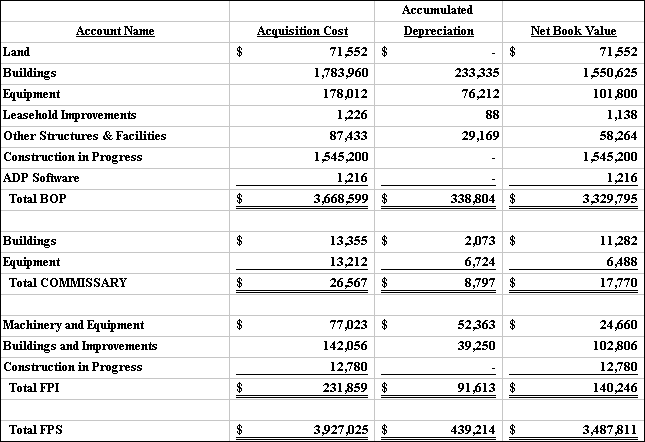
The accumulated depreciation for ADP Software is lumped into the accumulated depreciation
amount for equipment. Due to report timeliness, this amount will not be shown as a
separate figure. Beginning in fiscal year 1997, the accumulated depreciation amount will
be segregated between equipment and ADP software.
Note 8. Debt
For FPI, there were borrowings payable to the Treasury which resulted from a loan it received from the U.S. Treasury. During 1988, Congress granted FPI borrowing authority pursuant to Public Law 100-690. Under this authority, during fiscal year 1989, FPI borrowed $ 20,000 thousand from the U.S. Department of Treasury with a lump-sum maturity or optional date for re-negotiation of September 30, 1998. Please refer to note 1L for further information.
Note 9. Operating Leases
BOP leases various facilities and equipment accounted for as operating leases. Assets held under these leases consist primarily of offices, parking facilities, and warehouses. The majority of space occupied by BOP is leased by the General Services Administration (GSA). The space is assigned to BOP by GSA based on BOP's square footage requirements. The rent charged by GSA is based on approximate commercial rates for commercial space. BOP may terminate the leases with GSA; however, it is anticipated that BOP will continue to occupy and lease space from GSA in future years. The following table consolidates the operating leases for BOP, and reflects the majority of future lease payments. A breakdown of the future lease payments, by operating lease, is provided in the supplemental section of this financial statement.
Table 9.1 - BOP Operating Leases

Operating leases are not applicable to Trust Fund in this reporting period. FPI has
various operating lease agreements for certain of its facilities, including its central
office in Washington, DC. Under these agreements, total rent expense amounted to $
1,804 thousand ending September 30, 1996. FPI's Central Office relocated to a
purchased building in January 1997. Total leasing costs in FY 1997 will be $ 751 thousand
and will be immaterial in future years.
Note 10. Net Position
Net Position is comprised of the following five elements:
Unexpended Appropriations include the portion of FPS's appropriations represented by unobligated balances and undelivered orders. The unobligated balances are segregated below to show available and unavailable amounts.
Invested Capital represents the net investment of the Government in the reporting entity. This includes the acquisition cost of capitalized fixed assets financed by appropriations, less the reduction in investment due to depreciation, amortization, sales or exchanges, donations, other disposals, or the transfer to another entity or revolving fund.
Cumulative Results of Operations represents the net difference between (1) expenses and losses and (2) financing sources, including appropriations, revenues, and gains, since the inception of the activity.
Other represents revenue and expenses that are not part of the normal course of business for FPI or Commissary. These items may include scrap material sales, miscellaneous income and expenses, and overhead expenses.
Future Funding Requirements reflects liabilities reported in the Statement of Financial Position which are not covered by available budgetary resources.
Table 10.1 - Net Position as of September 30, 1996 (in thousands)

Note 11. Future Funding Requirements
Future funding requirements reflect other governmental liabilities reported in the Statement of Financial Position which are not covered by available budgetary resources. Future funding requirements are funding needs that will be met by future appropriations.
The FPI has adequate financial resources to relieve all liabilities presented on the Statement of Financial Position, therefore future benefit costs are categorized as Liabilities Covered by Budgetary Resources on the Statement of Financial Position.
For BOP and its combined operations, future funding requirements include accrued leave and actuarial liabilities. All future funding amounts are current except for the FECA liability. Unfunded expenses include future benefit costs (i.e., actuarial liabilities, accrued annual leave, accrued compensatory leave and contingent liabilities for the year presented). Leave and actuarial expenses are included in the Statement of Operations and Changes in Net Position as Future Compensation Benefits Cost. BOP has no contingent liabilities included as an Other Expense item. In Table 11.1, a summary of the unfunded liabilities as of September 30, 1996 is presented.
Unfunded expenses for BOP includes the current net accrued liability for annual and compensatory leave of $12,875 thousand and current FECA liability of $30,553 thousand.
Table 11.1 - Future Funding Requirements at September 30, 1996 (in thousands)
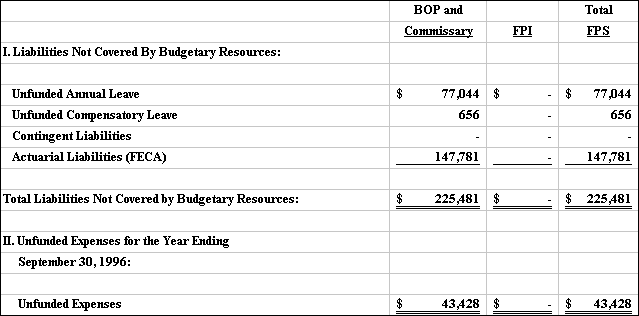
In accordance with Office of Management and Budget (OMB) guidance, each reporting entity
preparing financial statements under the Chief Financial Officers Act and the Government
Management Reform Act should include its respective portion of the actuarial liability for
workers' compensation benefits as a liability in its financial statement, if such amounts
are material. The FECA actuarial liability data is for financial statement presentation
only and should not be used as a standard for incorporating actuarial liabilities in fees,
prices, and reimbursements.
The amount provided for FECA liability could not be distinguished between BOP and Commissary, therefore, the full amount was reported as BOP's liability. BOP reports this liability as not covered by budgetary resources even though Commissary has adequate financial resources to relieve all liabilities.
Note 12. Other Revenues and Financing Sources
This is not applicable for BOP.
The Commissary receives the majority of the funding needed to support the program through revenues generated by the sale of merchandise and telephone services to inmates. Given that it is self-supporting, this program does not rely on appropriated funding. Also, the collection of commissions received from products sold through vending machines contributes substantially to net profit. FPI's other revenue is generated through scrap sales, sales of obsolete inventory, replacement parts sold to other federal agencies, and recycling revenues.
The total for other revenues and financing sources for Commissary and FPI for the year ending September 30, 1996 totaled $19,774 as presented in Table 12.1 below.
Table 12.1 - Other Revenues and Financing Sources for the year ending September 30, 1996
(in thousands)
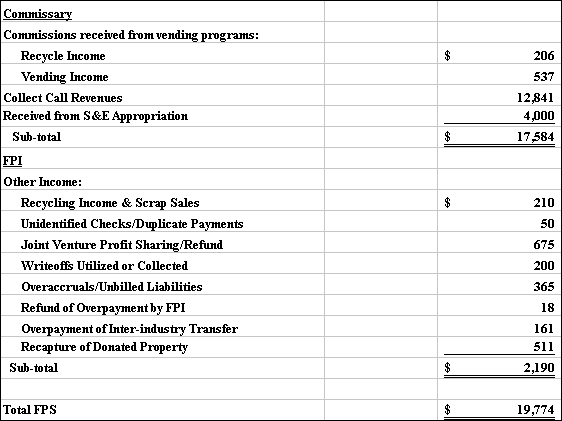
Note 13. Expenses
Expenses for BOP, Commissary and FPI for the year ending September 30, 1996 totaled $2,467,886. See table below.
Table 13.1 - Program Expenses by FPS Component (in thousands)

Note 14. Prior Period Adjustments
This is not applicable for FPI and BOP.
Prior period adjustments , presented below, made by the Commissary for fiscal year 1996
totaled ($18,310) thousand.
| · Payment for prior period expenses by the S&E Approp. during ITS litigation | $ ( 22,454) |
| · Prior year leave liability adjustments | ( 404) |
| · Equipment transfers not recorded as expense items | ( 49) |
| · Prior period Collect Call Revenues | 3,105 |
| · Non-monetary leave liability | 1,492 |
| $ ( 18,310) |
Note 15. Non-Operating Changes
Changes in the net position other than excess (shortage) of revenues over total expenses are presented in table 15.1:
Table 15.1 - Non-Operating Changes for the year ending September 30, 1996 (in thousands)
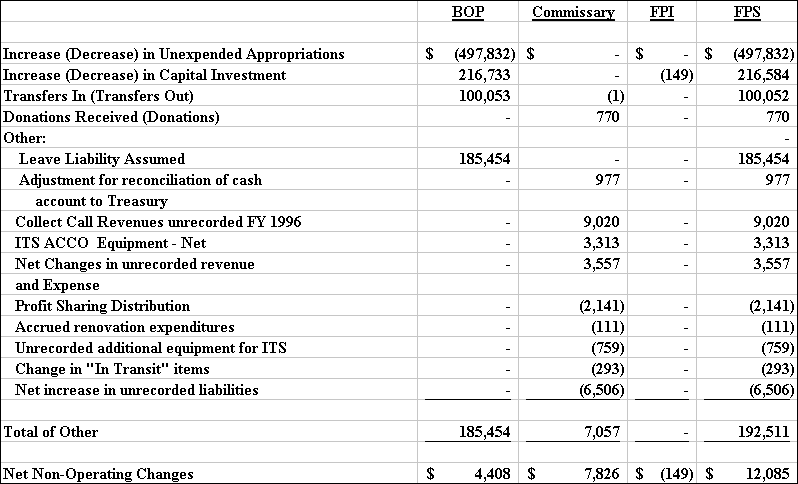
Note 16. Intragovernmental Financial Activities
This is not applicable for BOP and Commissary.
FPI's financial activities interact with and are dependent upon those of the Federal government as a whole. The following is a discussion of certain intergovernmental activities and their related interaction with FPI:
Relationship with the Federal Bureau of Prisons: FPI and the Federal Bureau of Prisons (BOP) have a unique relationship in that the nature of their respective missions requires the sharing of facilities and responsibilities relative to the custody, training and employment of federal inmates. The Director of the BOP serves as the Chief Executive Officer of FPI and the Chief Operating Officer of FPI serves as an Assistant Director of the BOP. The BOP provides land to FPI for the construction of its manufacturing facilities and both FPI and BOP share certain facilities, generally at no cost to FPI.
Product Sales: As mentioned within note 1E, FPI earns the majority of its revenues from the sales of products to other intragovernmental agencies.
Note 17. Other Governmental Liabilities
Other governmental liabilities for BOP, Commissary and FPI as of September 30, 1996 totaled $92,368 as presented in Table 17.1 below.
Table 17.1 - Other Governmental Liabilities as of September 30, 1996 (in thousands)
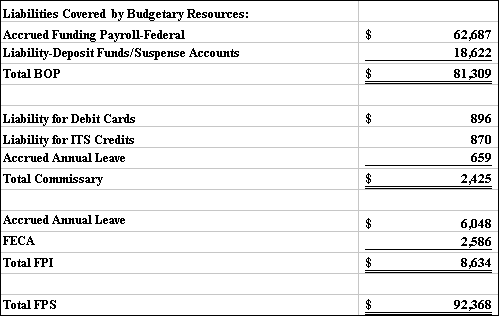
Note 18. Other Intragovernmental Liabilities
Other intragovernmental liabilities for BOP, Commissary and FPI as of September 30, 1996 totaled $ 42,344 as presented in Table 18.1 below.
Table 18.1. Other Intragovernmental Liabilities as of September 30, 1996 (in thousands)
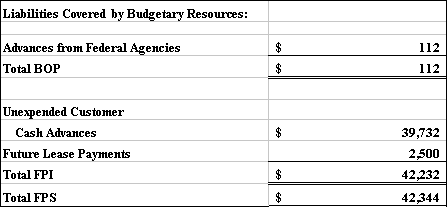
Note 19. Other Expenses
Other expenses for BOP, Commissary and FPI for the year ending September 30, 1996 totaled $33,835 as presented in Table 19.1 below.
Table 19.1 - Other Expenses for the year ending September 30, 1996 (in thousands)
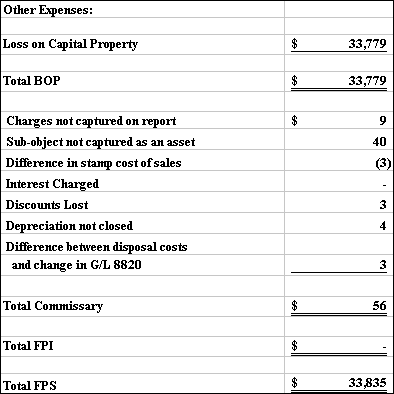
#####